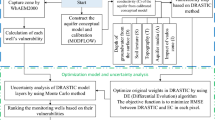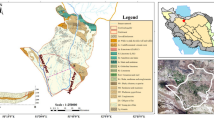Abstract
Unplanned and excessive utilization of groundwater increases the risk of seawater intrusion in coastal areas. Therefore, water quality management and monitoring in these areas are significantly important. For designing a monitoring network, the least number of monitoring wells with the optimal spatial distribution should select due to economic considerations. In this study, the optimal monitoring network with the minimum number of wells was selected in the coastal aquifer of Talesh County by considering the aquifer vulnerability maps and assessing the accuracy of the designed monitoring network. Accordingly, the aquifer vulnerability map was prepared using the modified GALDIT index, and then a genetic algorithm was used for optimal search in the monitoring network. The optimization model simultaneously analyzed three objectives: (1) to maximize the correlation between the vulnerability index and the EC value, (2) to minimize the number of monitoring wells, and (3) to maximize the Nash-Sutcliff coefficient that indicates the goodness of fit between the distribution of calculated EC in the existing monitoring network and the new network. The three objectives were integrated into one objective function by applying the weight coefficient w for economic reasons, and then the various weights were assessed. The results showed that the optimal solution selection significantly depended on determining the weight coefficient, and the best weight coefficient was selected by taking the most balanced solution into account according to the vulnerability index and the accuracy of the monitoring network. Satisfied predictions were achieved in both the optimization and the validation steps. Moreover, due to the qualitative and quantitative changes in groundwater in the long term, it should be assessed and redesigned the groundwater quality monitoring network periodically for the monitoring network to be effective in planning and applying methods for improving groundwater quality.












Similar content being viewed by others
Availability of Data and Materials
The data will be available upon reasonable request.
Reference:s
Amiri H, Azadi S, Javadpour S, Naghavi AA, Boczkaj G (2022) Selecting wells for an optimal design of groundwater monitoring network based on monitoring priority map: A Kish Island case study. Water Resources and Industry 27:100172
Antonakos A, Lambrakis N (2007) Development and testing of three hybrid methods for the assessment of aquifer vulnerability to nitrates, based on the drastic model, an example from NE Korinthia, Greece. J Hydrol 333(2–4):288–304
Ayvaz MT, Elçi A (2018) Identification of the optimum groundwater quality monitoring network using a genetic algorithm based optimization approach. J Hydrol 563:1078–1091
Ayvaz MT, Kentel E (2015) Identification of the best booster station network for a water distribution system. J Water Resour Plan Manag 141(5):04014076
Baalousha H (2010) Assessment of a groundwater quality monitoring network using vulnerability mapping and geostatistics: a case study from Heretaunga Plains, New Zealand. Agric Water Manag 97(2):240–246
Barca E, Bruno D, Lay-Ekuakille A, Maggi S, Passarella G (2018) Retrospective analysis: A validation procedure for the redesign of an environmental monitoring network. Measurement 113:211–219
Barzegar R, Razzagh S, Quilty J, Adamowski J, Pour HK, Booij MJ (2021) Improving GALDIT-based groundwater vulnerability predictive mapping using coupled resampling algorithms and machine learning models. J Hydrol 598:126370
Bordbar M, Neshat A, Javadi S, Pradhan B, Aghamohammadi H (2020) Meta-heuristic algorithms in optimizing GALDIT framework: A comparative study for coastal aquifer vulnerability assessment. J Hydrol 585:124768
Bordbar M, Neshat A, Javadi S, Shahdany SMH (2021) A hybrid approach based on statistical method and meta-heuristic optimization algorithm for coastal aquifer vulnerability assessment. Environ Model Assess 26(3):325–338
Chachadi A (2005) Seawater intrusion mapping using modified GALDIT indicator model: A case study in Goa
Chachadi A, Lobo-Ferreira J (2001) Sea water intrusion vulnerability mapping of aquifers using GALDIT method. Coastin 4:7–9
Chadalavada S, Datta B (2008) Dynamic optimal monitoring network design for transient transport of pollutants in groundwater aquifers. Water Resour Manage 22(6):651–670
Daughney CJ, Raiber M, Moreau-Fournier M, Morgenstern U, van der Raaij R (2012) Use of hierarchical cluster analysis to assess the representativeness of a baseline groundwater quality monitoring network: comparison of New Zealand’s national and regional groundwater monitoring programs. Hydrogeol J 20(1):185–200
Fisher JC (2013) Optimization of water-level monitoring networks in the Eastern Snake River plain aquifer using a kriging-based genetic algorithm method. US Department of the Interior, US Geological Survey
Gorgij AD, Kisi O, Moghaddam AA, Taghipour A (2017) Groundwater quality ranking for drinking purposes, using the entropy method and the spatial autocorrelation index. Environ Earth Sci 76(7):269
Guo Y, Wang J, Yin X (2011) Optimizing the groundwater monitoring network using MSN theory. Procedia Soc Behav Sci 21:240–242
Jin X, Ranjithan RS, Mahinthakumar G (2014) A monitoring network design procedure for three-dimensional (3D) groundwater contaminant source identification. Environ Forensic 15(1):78–96
Kavusi M, Khashei Siuki A, Dastourani M (2020) Optimal design of groundwater monitoring network using the combined Election-Kriging method. Water Resour Manage 34(8):2503–2516
Khader AI, McKee M (2014) Use of a relevance vector machine for groundwater quality monitoring network design under uncertainty. Environ Model Softw 57:115–126
Kim IH, Chung I-M, Chang SW (2021) Development of seawater intrusion vulnerability assessment for averaged seasonality of using modified GALDIT method. Water 13 (13):1820
Kruseman GP, De Ridder NA, Verweij JM (1970) Analysis and evaluation of pumping test data, vol 11. International institute for land reclamation and improvement. The Netherlands
Lobo-Ferreira J, Chachadi A, Diamantino C, Henriques M (2005) Assessing aquifer vulnerability to seawater intrusion using GALDIT Method. Part 1: application to the Portuguese aquifer of Monte Gordo
Luo Q, Wu J, Yang Y, Qian J, Wu J (2016) Multi-objective optimization of long-term groundwater monitoring network design using a probabilistic Pareto genetic algorithm under uncertainty. J Hydrol 534:352–363
McLean M, Evers L, Bowman A, Bonte M, Jones W (2019) Statistical modelling of groundwater contamination monitoring data: A comparison of spatial and spatiotemporal methods. Sci Total Environ 652:1339–1346
Mogheir Y, De Lima J, Singh V (2009) Entropy and multi-objective based approach for groundwater quality monitoring network assessment and redesign. Water Resour Manage 23(8):1603–1620
Moriasi DN, Arnold JG, Van Liew MW, Bingner RL, Harmel RD, Veith TL (2007) Model evaluation guidelines for systematic quantification of accuracy in watershed simulations. Trans ASABE 50(3):885–900
Nowak W, Rubin Y, de Barros FP (2012) A hypothesis‐driven approach to optimize field campaigns. Water Resour Res 48(6)
Recinos N, Kallioras A, Pliakas F, Schuth C (2015) Application of GALDIT index to assess the intrinsic vulnerability to seawater intrusion of coastal granular aquifers. Environ Earth Sci 73(3):1017–1032
Revelle R (1941) Criteria for recognition of the sea water in ground-waters. EOS Trans Am Geophys Union 22(3):593–597
Rosen L (1994) A study of the DRASTIC methodology with emphasis on Swedish conditions. Groundwater 32(2):278–285
Santhi C, Arnold JG, Williams JR, Dugas WA, Srinivasan R, Hauck LM (2001) Validation of the swat model on a large rwer basin with point and nonpoint sources 1. J Am Water Resour Assoc 37(5):1169–1188
Shetkar R, Mahesha A (2011) Tropical, seasonal river basin development: hydrogeological analysis. J Hydrol Eng 16(3):280–291
Singh J, Knapp HV, Arnold J, Demissie M (2005) Hydrological modeling of the Iroquois river watershed using HSPF and SWAT 1. J Am Water Resour Assoc 41(2):343–360
Umar R (2009) Groundwater Flow Modelling and Aquifer vulnerability assessment studies in Yamuna-Krishni Sub-basin, Muzaffarnagar District. Thinking 115:116
Van Liew M, Arnold J, Garbrecht J (2003) Hydrologic simulation on agricultural watersheds: Choosing between two models. Trans ASAE 46(6):1539
Wu S-C, Ke K-Y, Lin H-T, Tan Y-C (2017) Optimization of groundwater quality monitoring network using risk assessment and geostatistic approach. Water Resour Manage 31(1):515–530
Wu Y (2004) Optimal design of a groundwater monitoring network in Daqing, China. Environ Geol 45(4):527–535
Xiong Y, Luo J, Liu X, Liu Y, Xin X, Wang S (2022) Machine learning-based optimal design of groundwater pollution monitoring network. Environ Res 211:113022
Yang F-g, Cao S-y, Liu X-n, Yang K-j (2008) Design of groundwater level monitoring network with ordinary kriging. J Hydrodyn 20(3):339–346
Yang J-S, Jeong Y-W, Agossou A, Sohn J-S, Lee J-B (2022) GALDIT modification for seasonal seawater intrusion mapping using multi criteria decision making methods. Water 14(14):2258
Yang X-S, Gandomi AH, Talatahari S, Alavi AH (2012) Metaheuristics in water, geotechnical and transport engineering. Newnes
Author information
Authors and Affiliations
Contributions
Conceptualization, H.M and S.J; Methodology, H.M and S.J; Software, H.M, S.J and A.A; Validation, H.M, S.J and A.A; Formal analysis H.M, S.J and A.A; Investigation, H.M, S.J and A.A; Resources, H.M, S.J and A.A; data curation, H.M and S.J; Writing - original draft preparation, H.M, S.J and A.A; Writing - review and editing, S.J and A.A; Visualization, H.M, S.J and A.A; Supervision, S.J and A.A; Project administration, S.J and A.A. All authors have read and approved the final manuscript.
Corresponding author
Ethics declarations
Ethical Approval
The authors confirm that this article is original research and has not been published or presented previously in any journal or conference in any language (in whole or in part).
Consent to Participate
Participation in the study was voluntary; all participants agreed to participate in the study.
Consent to Publish
The authors approved the version to be published.
Competing Interests
The authors declare that they have no known competing financial interests or personal relationships that could have appeared to influence the work reported in this paper.
Additional information
Publisher's Note
Springer Nature remains neutral with regard to jurisdictional claims in published maps and institutional affiliations.
Rights and permissions
Springer Nature or its licensor (e.g. a society or other partner) holds exclusive rights to this article under a publishing agreement with the author(s) or other rightsholder(s); author self-archiving of the accepted manuscript version of this article is solely governed by the terms of such publishing agreement and applicable law.
About this article
Cite this article
Mahmoudpour, H., Janatrostami, S. & Ashrafzadeh, A. Optimal Design of Groundwater Quality Monitoring Network Using Aquifer Vulnerability Map. Water Resour Manage 37, 797–818 (2023). https://doi.org/10.1007/s11269-022-03404-w
Received:
Accepted:
Published:
Issue Date:
DOI: https://doi.org/10.1007/s11269-022-03404-w




